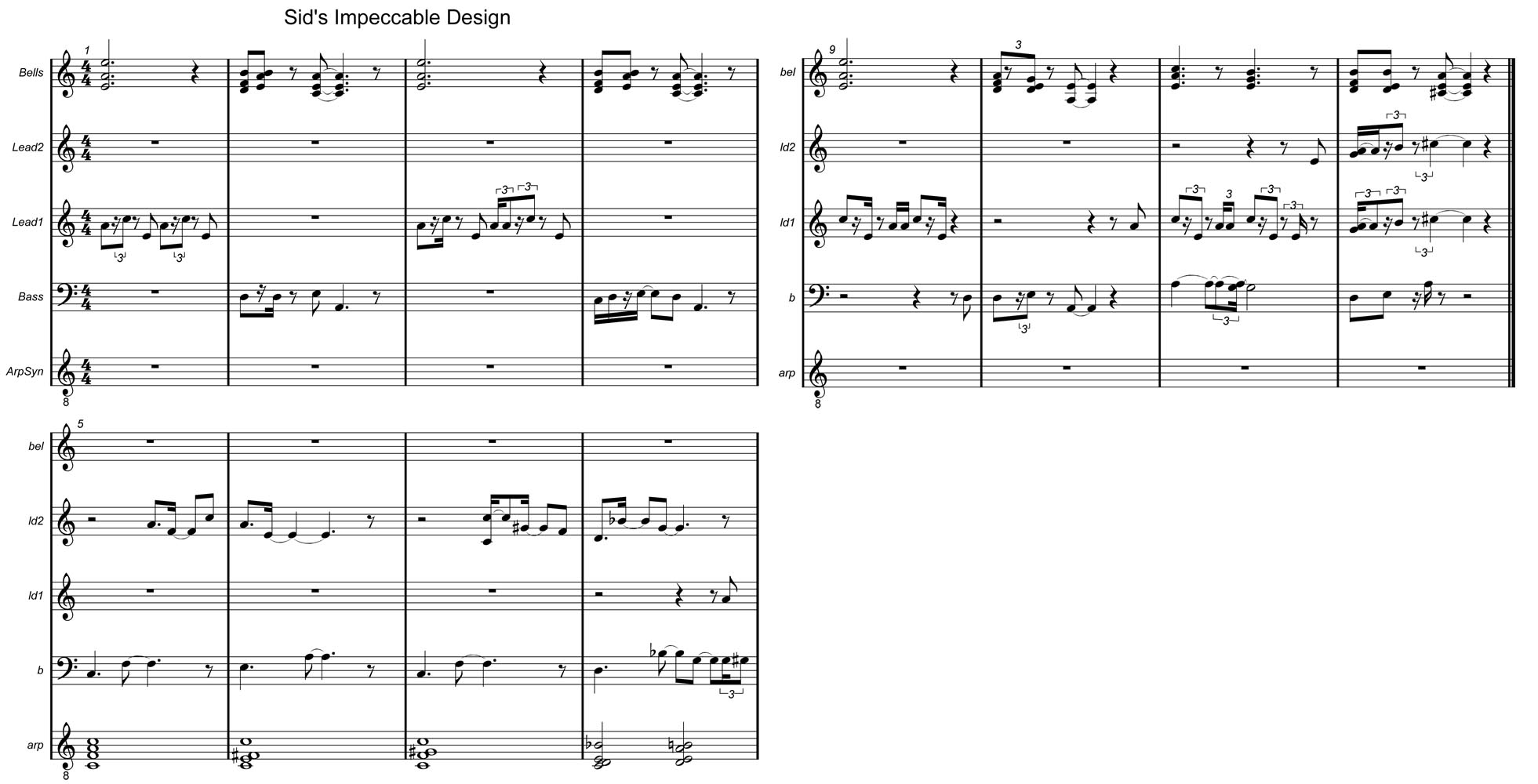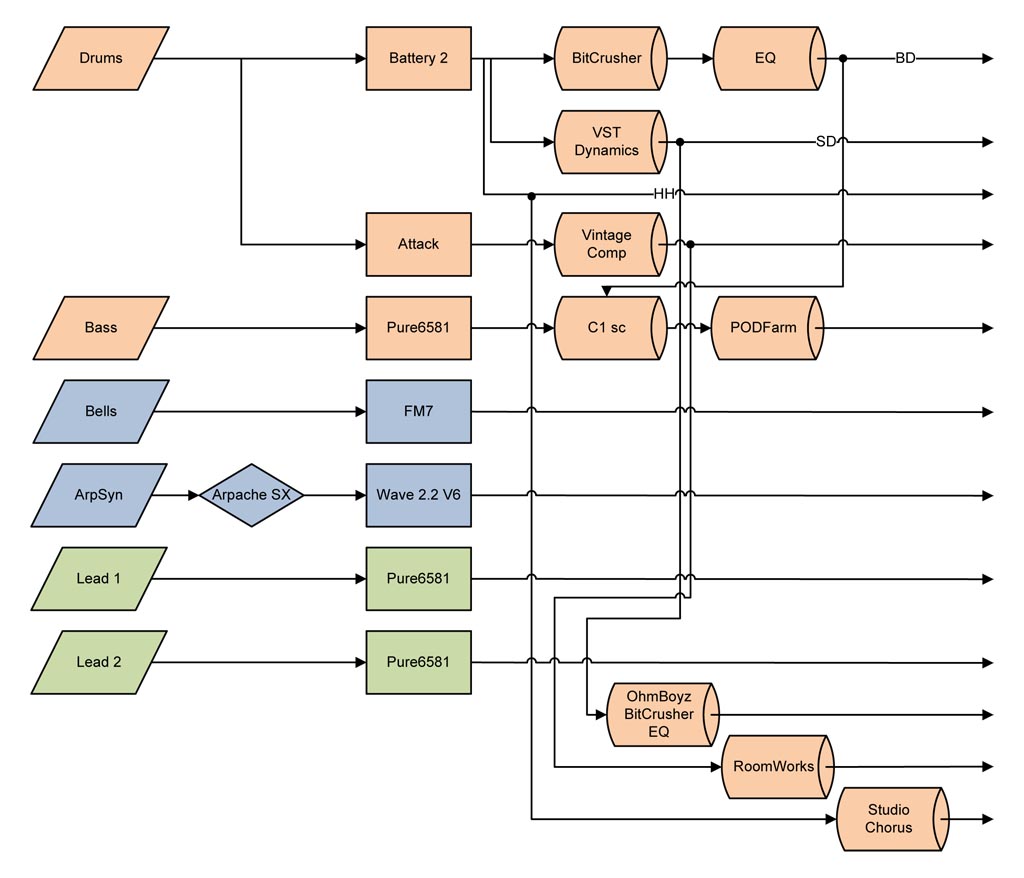First note about this new track – more details, and sheet music, about to follow!
This is a short track – the idea for which I had yesterday just before going to bed, and which I arranged/tracked/mixed in roughly two hours today – also making this an advance for me in getting short tracks done really fast.
Dominating elements: the two lead sounds and the bass synth are done using the pure6581 VST – in case of the bass synth sent through Line6′s POD Farm for added beef. Drums are mainly one of Battery’s electronic libraries (from the Battery 1 library), with an added punch snare from Waldorf Attack. The bell-like sounds are an FM7 of course, and the arpeggiated thingie is a virtual PPG (by Hermann Seib – search for it, it’s free and great!).
And as I said – more details coming later!
110617 Update: on to the details (note the Eighties’ font colour!)
1.The Music

Sid's Impeccable Design - score
It’s a very simple arrangement – a standard ABA form, or rather ABA’. You get a call-and-response schme by the first lead and the bass (both SID-sounds, with added harmonies done by FM7) over a I-IV-V turnaround in Am, before a drum fill takes us to the B part.
The B part takes us to the parallel F tonic, and has yet another SID lead set against an arpeggiating PPG Wave…and a drum groove fans of my work will be most familiar with: remember The Cosmo Sessions, back from 1999? For the kinda-title track, Welcome Aboard (on the Flying Sausage), I used a sample from the out chorus drum groove from the track What? off Joey Baron’s solo debut Down Home. Much later, I played my track to Blah drummer Phonky Phrance, asking him to replicate that groove – and then extracted that groove in Cubase from a recording of that session – as seen below (see the picture gallery).
We’re taken back to the A part – or rather something similar. This time, the drum groove continues. But now, the call-and-response motivs are not played downbeat as the first time, but rather reshuffled upbeat, before we end into a IV-V-I turnaround, hitting the tonic with a Tierce de Picardie for added cheesyness.
2. The Sound

Signal Flowchart
It’s Eighties time here – more specifically, Commodore 64 time.
We have no less than three SID implementations here (Pure6581 VST) – for both lead sounds and for the punchy bass.
The bass, as said, is a Pure6581 – which goes through Cubase’s EQ, then through a sidechained compressor (triggered by the bass drum), and then through PODFarm – with two channels: a Sunn Coliseum amp and the Justin-Meldal-Johnsen-signature “SubDub” virtual amp – both of them tamed by the Teletronix LA2A compressor.
Both leads are completely unprocessed after the synths – as is the bell-like harmonies in the intro (NI FM7). Same goes for the arpeggiated harmonies in the B part. Here, the chords are sent through Cubase’s Arpache SX, then feeding Hermann Seib’s PPG Wave 2.2 VST – another fantastic freebie!
Finally the drums: let’s start with the very prominent snare. It’s Waldorf’s Attack (an edited verysion of the Newstyle Kit’s main snare), sent through the VintageCompressor and then reverberated by a Roomwork’s Gated Reverb. The rest of the kit? Battery2 has, from the Battery 1 library, a set called “80s Elektro”, and that’s it. The BD, of course, is sent through a Bitcrusher, then trough a VSTDynamics and then trough an EQ. The snare? VSTDynamics, and just a hint of OhmBoyz Delay multiapping – through Bitcrusher, and through a lowpass. Finally, the hihat – just Cubase’s great StudioChrous, with completely whacked out settings.
That’s about it for the processing – and I have to admit, it’s quite a lot. Noteworthy detail here: with the exception of the genre-and-epoque-typical gated reverb on the main snare, no reverb!
Ah, of course, all parts tracked using the Kurzweil K2600XS as a masterkeyboard (with the exception of the drums, which were extracted from Ponky’s groove, and then dynamically treated with the Akai MPD24′s trigger pads).





Sid`s …ist sehr lustig.Aber eine Frage:Wandelst Du mit fridge und bottom freezer auf den Spuren von Axel Hacke?
In Anbetracht meines, allem Geblödel und aller “komischen Elektronik” zum Trotz, durchaus hohen künstlerischen Anspruchs ist die Antwort natürlich “Nein!” (mit Ausrufezeichen)